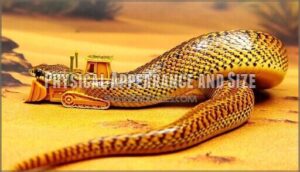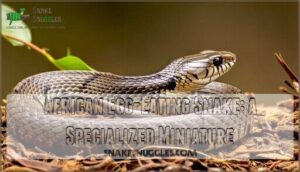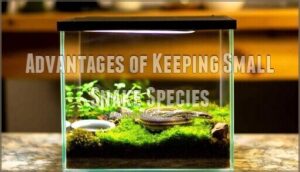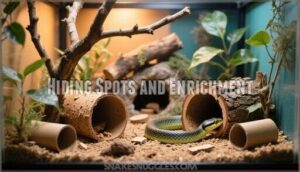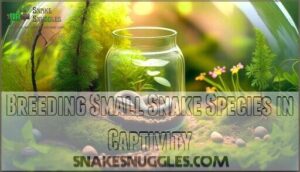This site is supported by our readers. We may earn a commission, at no cost to you, if you purchase through links.
 Looking for the best snake breeds that stay small and don’t grow into room-sized reptiles? You’re in luck.
Looking for the best snake breeds that stay small and don’t grow into room-sized reptiles? You’re in luck.
Rosy boas top the list at just 24-36 inches, followed by western hognose snakes that max out around 20 inches. Ringneck snakes stay remarkably tiny at 10-15 inches, making them perfect apartment pets.
Kenyan sand boas reach only 16-24 inches with their stocky, adorable build. These compact species offer manageable care requirements, smaller enclosures, and reduced feeding costs compared to their larger cousins.
Each brings unique personalities and stunning color variations that’ll surprise you with their diversity and charm.
Table Of Contents
- Key Takeaways
- Top Small Snake Breeds for Pet Owners
- Characteristics of Snakes That Stay Petite
- Care Requirements for Compact Snake Species
- Kenyan Sand Boa: a Pocket-Sized Desert Dweller
- Garter Snakes: Tiny Terrors of The Garden
- African Egg-Eating Snake: a Specialized Miniature
- Advantages of Keeping Small Snake Species
- Health Considerations for Tiny Snake Breeds
- Creating The Perfect Habitat for Small Snakes
- Breeding Small Snake Species in Captivity
- Frequently Asked Questions (FAQs)
- What are the best small pet snakes?
- What is the smallest snake you can keep as a pet?
- What are the best small snakes for beginners?
- Are small snakes good pets?
- What pet snakes stay the smallest?
- What is the most low maintenance snake?
- What is the friendliest snake to own?
- What kind of snakes don’t get big?
- How often do small snakes need to be fed?
- Can small snakes be housed together safely?
- Conclusion
Key Takeaways
- You’ll save money and space with small snake breeds, like Rosy Boas (24-36 inches) and Western Hognose snakes (20 inches max), which need smaller enclosures and eat less frequently than larger species.
- Beginner-friendly handling becomes easier when you’re working with compact snakes under 24 inches – they’re less intimidating, fit comfortably in your hands, and species like Ball Pythons offer docile temperaments perfect for new keepers.
- Specialized care requirements vary by species – while Kenyan Sand Boas need desert-like conditions with deep substrate, African Egg-Eating snakes require a specialized diet of bird eggs that can be challenging to source consistently.
- You’ll get 15-30 years of companionship from these small breeds, with proper care, including temperature gradients of 75-90°F, appropriate humidity levels, and feeding schedules every 7-14 days for adults.
Top Small Snake Breeds for Pet Owners
When you’re looking for a snake that won’t outgrow your apartment, these compact species offer all the charm of larger reptiles in a space-friendly package.
You’ll find that small snake breeds like Rosy Boas, Western Hognose Snakes, and Ringneck Snakes make excellent pets for both beginners and experienced keepers who prefer manageable-sized companions.
Rosy Boa
The rosy boa stands out among small snake breeds as an ideal choice for beginner snakes enthusiasts.
Perfect starter serpents for space-conscious reptile enthusiasts seeking manageable, docile companions
These pet snakes typically reach 24-36 inches, displaying beautiful rosy stripes that vary based on their natural habitat.
Their temperament traits include exceptional docility and stress tolerance, making them perfect starter serpents.
Unlike many species, rosy boas show remarkable color morphs ranging from desert tones to vibrant oranges.
Their conservation status remains stable, and they thrive with minimal enclosure enrichment, requiring only basic hiding spots and substrate for burrowing.
Ball Python
Ball Python enthusiasts appreciate these gentle giants that reach 3-5 feet.
Their docile snakes temperament makes them perfect beginner snakes among small snake breeds.
Morph Variations offer stunning color options.
You’ll need basic Enclosure Enrichment and consistent temperatures.
Their Temperament Quirks include defensive ball-curling behavior.
While Feeding Challenges occasionally arise, their Beginner Suitability remains unmatched for pet snakes lovers.
Ringneck Snake
Ringneck Snake enthusiasts know these 10-15 inch gems pack serious charm. Their signature orange neck ring makes identification easy, while their secretive nature appeals to keepers who appreciate subtle beauty.
Here’s what makes ringneck snakes special:
- Their defensive behaviors include tail-curling displays that flash bright belly colors
- Dietary specifics focus on earthworms and slugs, requiring live invertebrate feeding
- Enclosure enrichment needs moist substrate and multiple hiding spots
- Conservation status remains stable across their North American range
These nonaggressive snakes suit experienced keepers comfortable with invertebrate diets rather than beginner snakes, offering a unique opportunity to observe their secretive nature and appreciate their subtle beauty in a well-designed enclosure with the right moist substrate.
Western Hognose Snake
Western Hognose Snake enthusiasts appreciate these theatrical performers with their distinctive upturned snout and quirky behaviors.
These small pet snakes reach 14-24 inches, making them ideal for beginner snake owners.
When threatened, they’ll hiss dramatically before playing dead completely upside-down.
Their mild venom only affects amphibians, not humans.
Scenting prey with frog scent encourages feeding in picky eaters.
These small snake breeds combine manageable size with entertaining personalities, perfect for pet snakes with character.
Corn Snake
Corn snakes represent the perfect starter species for beginner snake owners seeking reliable, manageable pets.
These docile reptiles typically reach 2-6 feet in length, making them ideal small snake breeds for home environments. You’ll appreciate their calm temperament variations and straightforward snake care requirements that minimize feeding challenges.
Here’s what makes corn snakes exceptional pet snakes:
- Stunning cornsnake morphs: Classic orange patterns to striking albino varieties
- Beginner friendliness: Rarely bite and tolerate regular handling sessions
- Simple diet: Frozen-thawed rodents every 7-14 days
- Moderate enclosure enrichment: Basic hiding spots and climbing branches satisfy their needs
- Long lifespan: 15-20 years of companionship with proper care
Their hardy nature and predictable behavior make corn snakes the golden standard for first-time reptile enthusiasts.
Characteristics of Snakes That Stay Petite
When you’re considering small snake species, understanding their adult dimensions helps you plan proper housing and long-term care commitments.
Most petite snake breeds reach their full size within two to three years, with adult lengths ranging from just four inches for the tiny Barbados threadsnake to about three feet for larger small species like ball pythons.
Average Adult Lengths
Small snakes typically measure between 8-24 inches at maturity, though size comparisons reveal fascinating growth variance among species.
The Barbados threadsnake claims the title of smallest at just 4 inches, while Western Hognose snakes reach up to 24 inches.
Sexual dimorphism affects maximum lengths substantially – male Ball Pythons average 2-3 feet, but females stretch to 5 feet.
Measurement techniques show Ringneck snakes consistently stay under 15 inches, making them perfect dwarf snakes for compact spaces.
These mini snakes prove that average length varies dramatically between species, with some remaining truly pocket-sized throughout their lives, demonstrating fascinating growth variance and significant differences in maximum lengths.
Weight Ranges
Understanding weight ranges helps you choose the right small snake for your setup and monitor their health effectively.
These compact companions vary substantially in their adult weights, even within similar-sized species.
Here’s what you can expect for average weights:
- Bantamweight champions: Ringneck snakes and Barbados threadsnakes weigh just 0.6-1.5 grams
- Lightweight contenders: Western hognose snakes and scarlet kingsnakes reach 50-70 grams
- Featherweight favorites: Ball pythons and rosy boas top out around 1-3 pounds maximum
Juvenile weights start much smaller, with most species gaining weight steadily during their first two years.
Weight fluctuation occurs naturally with feeding cycles, but consistent monitoring prevents obesity risks in captive small snakes.
Growth Rates
During their first year, growth rates vary substantially among small snakes based on genetic influence and environmental factors.
Feeding impact determines how quickly juveniles reach maturity size, with consistent meals accelerating development through growth stages.
| Species | Hatchling Length | Adult Length | Time to Maturity |
|---|---|---|---|
| Ringneck Snake | 4-6 inches | 10-15 inches | 18-24 months |
| Western Hognose | 6-9 inches | 14-24 inches | 2-3 years |
| Rosy Boa | 10-12 inches | 24-36 inches | 3-4 years |
Snake growth slows after reaching sexual maturity, with average length stabilizing once they’ve completed major growth stages, influenced by factors such as environmental factors and feeding impact, leading to variations in growth rates and time to maturity.
Lifespan Expectations
Preparing for a long-term commitment with your petite serpent? Snake lifespan varies substantially among compact species, making snake longevity expectations an important consideration before bringing one home.
Factors affecting longevity include genetics, diet quality, husbandry practices, and preventive veterinary care. Proper nutrition and consistent environmental conditions help maximize snake aging gracefully while minimizing common ailments like respiratory infections or parasites.
Here’s what you can expect from popular small species:
- Rosy boas often reach 20-30 years with exceptional care
- Ball pythons typically live 20-25 years in captivity
- Corn snakes average 15-20 years with proper husbandry
- Western hognose snakes generally live 15-18 years
Extending lifespan requires consistent temperatures, appropriate feeding schedules, and regular health monitoring. End-of-life care becomes important as your snake enters its senior years.
Care Requirements for Compact Snake Species
You’ll find that caring for small snake species requires attention to specific details, though their compact size makes setup simpler than larger species.
These miniature serpents need properly sized enclosures, precise temperature gradients, and feeding schedules adapted to their smaller prey requirements.
Enclosure Size and Setup
Setting up your snake’s home requires careful attention to tank dimensions and enclosure size. Most small species thrive in 36" x 12" terrariums or 32-quart plastic tubs.
Your snake enclosure needs secure lids, proper ventilation, and substrate options like aspen shavings or cypress mulch. Include multiple hiding spots on both warm and cool sides.
Position heating methods like under-tank heaters covering one-third of the floor space for proper thermal gradients. Choosing the right snake tanks is essential for creating a suitable environment for your pet snake.
Temperature and Humidity Needs
Proper temperature control keeps your small snake comfortable and healthy. You’ll need heat gradients with a warm basking spot at 85-90°F and a cool retreat at 75-80°F.
Most compact species thrive with humidity levels between 40-60%, though some prefer higher moisture management.
Key temperature and humidity requirements include:
- Thermal cycling – Allow nighttime temperatures to drop 5-10°F naturally
- Humidity maintenance – Use digital hygrometers to monitor moisture levels accurately
- Temperature management – Under-tank heaters work better than overhead bulbs for burrowing species
- Thermoregulation support – Provide temperature gradients so snakes can self-regulate their body heat
Accurate humidity control devices are essential for maintaining ideal environmental conditions.
Feeding Schedules and Prey Sizes
Successful snake nutrition requires careful attention to feeding schedules and prey selection.
Most small snakes thrive on feeding frequency every 7-14 days for adults, while juveniles need meals every 5-7 days.
Prey items should match your snake’s mid-body width to prevent digestive complications.
| Species | Feeding Frequency | Prey Size Guidelines |
|---|---|---|
| Ball Python | Every 10-14 days (adult) | Fuzzy mice to small rats |
| Ringneck Snake | 2-3 times weekly | Earthworms, small invertebrates |
| Western Hognose | Every 7-10 days (adult) | Appropriately sized rodents |
Frozen prey offers convenience while meeting nutritional needs safely, and is a good option for snake owners who want to provide their pets with a variety of food options, including frozen prey items.
Handling Techniques for Small Snakes
Small snakes require careful handling techniques that prioritize their safety and comfort. When working with these delicate creatures, you’ll need to master gentle movements and proper support methods.
Gentle movements and proper support protect these delicate serpents from injury during handling sessions
Gentle Handling starts with warming your hands, as cold contact can shock small pet snakes. Always move slowly when approaching Small Enclosures to avoid startling your snake. Support their body weight completely, never grabbing just the head or tail.
Here are three essential Safety Precautions for Snake Handling:
- Use proper Snake Support by cradling the body with both hands, distributing weight evenly
- Employ Handling Tools like snake hooks for defensive species or when cleaning enclosures
- Monitor stress signals such as rapid breathing, defensive posturing, or attempts to hide
Pet Snakes under two feet long need extra consideration during handling sessions. Their small size makes them more vulnerable to injury from drops or excessive pressure. Keep sessions brief, typically five to ten minutes, allowing your snake to feel secure throughout the process.
Kenyan Sand Boa: a Pocket-Sized Desert Dweller
If you’re looking for a snake that won’t outgrow your apartment, the Kenyan Sand Boa (Gongylophis colubrinus) might be your perfect match.
These stocky desert natives typically reach only 16-24 inches as adults, making them one of the most compact boa species you can keep as a pet.
Physical Appearance and Size
Within these tiny desert dwellers, you’ll discover remarkable size consistency. Snake Length reaches maximum dimensions of 20 inches for males and 24 inches for females.
Their compact Body Shape resembles miniature bulldozers, featuring thick, cylindrical torsos perfectly adapted for underground life.
| Feature | Male | Female |
|---|
Head Size
Color Patterns showcase stunning yellow-orange base tones with distinctive brown or black blotches creating natural camouflage. Scale Texture feels smooth and glossy, reflecting light beautifully.
These small snakes represent ideal pet snakes for enthusiasts seeking manageable small snake pet options among tiny snakes varieties. Understanding the kenyan sand boa care requirements is essential for providing a suitable environment for these animals.
Habitat Preferences
Creating the right snake enclosure setup for your small snake pet means replicating authentic desert terrains.
Unlike forest floors or tropical swamps, these burrowers need deep, loose substrate mimicking sandy dunes and rocky outcrops.
Maintain temperatures between 75-95°F with UVB lighting for ideal health.
Keep humidity around 50-60% – perfect for apartment snakes requiring minimal space.
Your snake habitat should include caves and drought-resistant plants, creating an engaging mini-ecosystem that supports natural burrowing behaviors in compact enclosure size requirements.
Temperament and Handling
Despite their docile nature, Kenyan Sand Boas require gentle handling and minimal stress.
These calm snakes demonstrate excellent snake temperament when handled properly. Your handling tips should include weekly sessions at most, using slow movements during gentle interaction.
Snake behavior indicates stress through hiding or food refusal. Conduct temperament tests by gently tapping with a paper towel before pickup.
Small snake care emphasizes comfort over frequent handling, making these docile reptiles perfect for patient keepers who understand snake handling basics.
Breeding and Morphs
Breeding Kenyan sand boas opens up exciting possibilities for creating unique color variations and genetic mutations.
These small snake breeds showcase fascinating morph genetics through careful breeding techniques.
- Morph genetics: Recessive traits like albino and anerythristic create stunning combinations
- Breeding techniques: Temperature cycling triggers reproductive behavior in adult pairs
- Color variation: Paradox patterns and striped morphs command premium prices
- Genetic mutations: Line breeding intensifies desirable traits across generations
Understanding snake hybridization helps maximize your breeding success while maintaining healthy bloodlines.
Garter Snakes: Tiny Terrors of The Garden
You’ll find garter snakes among the most accessible small species for beginners, with most varieties staying under 24 inches and adapting well to captive conditions.
These hardy North American natives offer active personalities and interesting feeding behaviors that make them engaging pets despite their diminutive size.
Species Variations
Garter snakes showcase remarkable diversity across their range, making them fascinating subjects for reptile enthusiasts.
These tiny snakes display stunning genetic traits through various snake morphs and color patterns that differ substantially by geographic location.
| Morph Type | Color Pattern | Size Range |
|---|---|---|
| Classic Striped | Yellow/white stripes on dark base | 18-26 inches |
| Red-sided | Bright red lateral markings | 20-28 inches |
| Melanistic | Solid black coloration | 16-24 inches |
| Checkered | Alternating light/dark squares | 22-30 inches |
Species hybrids occasionally occur in overlapping territories, creating unique combinations of parental traits.
These small snakes adapt their appearance to local environments, with some populations developing specialized breeding methods that produce distinct regional variations in pet snakes.
Diet and Feeding Habits
In terms of feeding techniques and prey selection, garter snakes are nature’s ultimate opportunists with diverse nutritional needs.
Their snake diet includes:
- Earthworms and slugs for easy digestion
- Small frogs and fish for protein variety
- Insects and spiders as supplemental prey items
- Occasional small rodents for balanced nutrition
Feeding frequency varies seasonally, with adults eating every 7-10 days during active months.
Their quick strikes and efficient swallowing make feeding schedules flexible, though consistency helps maintain healthy growth patterns.
Social Behavior
Unlike their solitary reputation, garter snakes display remarkable Snake Interactions and Group Dynamics that’ll surprise you.
These tiny serpents form complex communities where older females become social hubs, demonstrating advanced Social Learning patterns.
They use chemical cues for Communication Styles, recognizing neighbors and following scent trails like breadcrumbs.
During breeding season, multiple males court single females in writhing mating balls – nature’s own speed dating.
Their snake social behavior includes sharing hibernation sites called hibernacula, where hundreds gather for warmth.
This snake companionship challenges traditional views about reptile intelligence and snake temperament, with snake behavior studies revealing sophisticated social species traits rarely seen in other snakes.
Captive Care Considerations
Setting up proper snake enclosures for garter snakes requires attention to specific details.
Males need 15-gallon tanks while females require 25-gallon spaces.
Maintain temperature gradients between 75-85°F using under-tank heaters.
Humidity control should stay around 50-60% with digital monitoring.
Choose appropriate substrate options like aspen shavings for burrowing.
These low maintenance snakes accept various feeding techniques, thriving on earthworms and pinkie mice.
Your snake care routine becomes straightforward once you establish consistent environmental conditions.
African Egg-Eating Snake: a Specialized Miniature
You’ll find the African egg-eating snake (Dasypeltis species) fascinating with its remarkable ability to consume eggs nearly three times its head diameter, thanks to specialized throat bones that puncture and drain the contents before regurgitating the empty shell.
These slender serpents typically reach 24-30 inches in length and display muted brown or gray coloration with darker patterns, making them excellent camouflage artists in their natural habitat.
Unique Dietary Requirements
African egg-eating snakes showcase extreme dietary specialization, consuming only bird eggs throughout their lives.
These picky eaters reject traditional snake prey like rodents completely. You’ll need consistent access to appropriately sized eggs from finches, canaries, or quail to meet their unique dietary requirements.
Feeding frequency varies based on egg availability and prey size. Some keepers use scenting techniques when introducing new egg types, though dietary supplements aren’t typically necessary for healthy specimens.
Jaw Adaptations for Egg Consumption
You’ll marvel at how African egg-eating snakes transform their anatomy for this specialized feeding behavior.
Their gape size expands dramatically through exceptional skull flexibility, allowing them to consume eggs three times their head diameter.
The snake’s vertebral hypapophyses act like internal egg-crackers, piercing shells during swallowing.
Here’s their remarkable egg ingestion process:
- Jaw dislocation – Both upper and lower jaws unhinge completely
- Throat expansion – Esophageal modifications create a flexible feeding tube
- Shell puncturing – Bony projections crack eggs internally
- Regurgitation – Empty shells get expelled after contents are swallowed
These jaw adaptations make African eggeating snakes uniquely suited to their dietary requirements, demonstrating nature’s incredible specialization in snake feeding strategies.
Size and Coloration
Beyond their unique feeding adaptations, you’ll find African Egg-Eating small snakes reach 12-39 inches with fascinating snake patterns.
These tiny snakes showcase color morphs ranging from browns to grays with intricate hue variations. Their scale texture creates detailed camouflage patterns, while body proportions remain slender throughout growth.
Some species mimic dangerous vipers through clever coloration, making pet snakes identification tricky for beginners exploring small snake types.
Understanding their captive care needs is essential for providing the right environment for these unique pets.
Challenges in Captive Care
Keeping African Egg-Eating Snakes presents unique challenges in captive care that test even experienced keepers.
These small snake types demand specialized attention across multiple areas:
- Snake Escapes: Secure enclosures with tight-fitting lids prevent these nimble climbers from vanishing
- Feeding Issues: Sourcing appropriately-sized quail or finch eggs becomes a constant hunt
- Habitat Design: Balancing humidity levels between 60-80% while maintaining proper ventilation
- Health Risks: Wild-caught specimens often carry internal parasites requiring immediate veterinary treatment
- Handling Techniques: Minimizing stress through gentle, infrequent interactions during acclimation periods
Unlike low maintenance snakes, these specialists don’t adapt easily to standard snake care requirements, making their snake size variation both appealing and problematic for captive breeding success.
Understanding egg eating habits is essential for their care.
Advantages of Keeping Small Snake Species
You’ll discover that small snake species offer practical advantages that make reptile ownership more accessible and enjoyable.
These compact serpents require smaller enclosures, cost less to feed, and present fewer handling challenges for new keepers while maintaining all the fascinating behaviors of their larger relatives.
Space-Saving Benefits
Small snakes offer remarkable space efficiency for urban dwellers and apartment residents.
These tiny snakes thrive in compact enclosures measuring just 10-20 gallons, transforming any corner into a miniature habitat.
Space-saving benefits include reduced footprint requirements compared to larger reptiles, making small species ideal for cramped living situations.
Your desk, bookshelf, or nightstand can easily accommodate these low-maintenance snakes without overwhelming your room’s layout or functionality.
Lower Maintenance Costs
Budget-conscious snake enthusiasts can cut back on expenses substantially with smaller species.
These compact companions offer substantial savings across multiple areas of reptile ownership.
Lower maintenance costs include:
- Feeding Costs – Small pet snakes eat appropriately-sized prey every 7-14 days, requiring fewer and smaller rodents than larger species
- Space Savings – Compact enclosures (10-20 gallons) cost less initially and require minimal heating equipment for energy efficiency
- Care Expenses – Low maintenance snakes need fewer veterinary visits and simpler husbandry setups
- Budget Planning – Predictable monthly expenses make financial planning straightforward for snake care costs
Easier Handling for Beginners
Handling small snakes creates confidence-building opportunities for newcomers to reptile care.
These best pet snake species measure under 24 inches, making them far less intimidating than their larger cousins.
Your gentle touch techniques develop naturally with smaller specimens, reducing common beginner mistakes like gripping too tightly or dropping nervous pets.
Easy snakes like Rosy Boas and Western Hognose tolerate handling better, while their compact size fits comfortably in your hands.
Small enclosures mean easier access during cleaning or health checks.
Essential handling tips include supporting their body properly and moving slowly.
Snake safety protocols become second nature when working with manageable sizes, creating a foundation for future success with larger species.
Reduced Feeding Expenses
With small snakes, feeding costs drop dramatically compared to larger species.
These low maintenance snakes require smaller prey sizes, from pinkie mice to small adult mice, reducing your budget care expenses substantially.
Snake feeding schedules stretch longer between meals, and food savings accumulate quickly.
Your pet snake suitability improves when reduced feeding expenses make ownership affordable long-term.
Health Considerations for Tiny Snake Breeds
Small snakes face unique health challenges that differ substantially from their larger counterparts, requiring specialized veterinary knowledge and careful monitoring from owners.
You’ll need to recognize subtle signs of illness early, as these tiny species can decline rapidly and may not show obvious symptoms until conditions become serious.
Common Health Issues
Despite their compact size, small snakes face numerous health challenges that require vigilant monitoring.
Respiratory issues manifest as wheezing, open-mouth breathing, and lethargy, typically caused by inadequate heating or humidity.
Skin problems include dysecdysis and scale rot from poor environmental conditions.
Feeding difficulties and metabolic disorders often stem from inappropriate prey sizes or nutritional imbalances.
Parasite control becomes critical as mites and internal parasites weaken these delicate species, making them susceptible to secondary infections that can prove fatal.
Excess humidity can also lead to ulcerative dermatitis issues, requiring careful attention to their environment.
Preventative Care Measures
Thorough preventative care measures protect your small snake from developing serious health complications throughout its lifetime.
Regular quarantine protocols for new acquisitions prevent disease transmission, while consistent parasite prevention treatments eliminate internal and external threats.
Proactive checkups with a qualified reptile veterinarian catch potential issues early, and proper hydration strategies prevent shedding problems and dehydration.
Understanding the importance of environmental and rodent control can also greatly reduce snake encounters.
- Establish quarantine protocols lasting 60-90 days for new snakes
- Schedule routine parasite prevention treatments every 6-12 months
- Maintain consistent hydration strategies through proper humidity control
- Arrange proactive checkups annually with an experienced reptile veterinarian
Signs of Illness in Small Snakes
Recognizing illness early can save your small snake’s life.
Lethargy signs include reduced movement and lack of curiosity about their environment.
Respiratory issues manifest as wheezing, mouth breathing, or mucus around the nostrils.
Appetite loss lasting more than two feeding cycles warrants concern.
Shedding problems occur when skin remains stuck, especially around eyes or tail tips.
Scale abnormalities like discoloration, swelling, or unusual texture indicate potential infections.
Watch for unusual positioning like "stargazing" behavior, where snakes crane their necks upward repeatedly.
Finding a Reptile Veterinarian
Finding qualified reptile veterinarians requires targeted research and preparation for your small snake’s specialized needs.
Start by checking the Exotic Vet Locator database or contacting local reptile organizations for recommendations.
Essential qualifications to verify include:
- Board certification in exotic animal medicine or reptile specialist credentials
- Experience treating your specific snake species and common health issues
- Emergency reptile care availability for urgent situations.
Research reptile specialist cost upfront, as veterinary care fees vary substantially.
Establish preventative reptile healthcare relationships before problems arise, ensuring your snake vet understands your pet’s unique requirements and can provide thorough snake health services when needed.
Creating The Perfect Habitat for Small Snakes
Creating the perfect habitat for your small snake requires careful attention to four essential elements that directly impact their health and behavior.
You’ll need to balance substrate choices, hiding spots, proper lighting and heat sources, plus water and humidity management to replicate their natural environment in a compact space, considering complete concepts to ensure the best results.
Substrate Choices
Your substrate choice directly impacts your small snake’s health and comfort. Aspen shavings provide excellent burrowing opportunities while maintaining proper substrate humidity levels around 50-60%.
Paper towels work well for quarantine situations and offer easy cleaning frequency management. Avoid cedar or pine substrates due to substrate toxicity concerns.
Naturalistic substrates like cypress mulch suit species requiring higher humidity levels. You can find a variety of snake bedding options online.
Monitor your enclosure’s humidity with a digital hygrometer, adjusting substrate moisture as needed to maintain ideal conditions. Clean soiled areas immediately and replace the entire snake substrate monthly to prevent bacterial growth.
Hiding Spots and Enrichment
Creating a secure environment means providing multiple hiding spots throughout your small snake’s enclosure.
Position cork bark tubes, hollow logs, and artificial caves on both warm and cool sides to encourage natural behaviors.
Enclosure complexity increases when you add climbing opportunities like sturdy branches for arboreal species.
Mental stimulation comes from varying hiding spot locations during cleaning.
Naturalistic design elements promote foraging behaviors, helping reduce stress in captive environments.
Snake enrichment doesn’t require expensive materials—cardboard tubes work perfectly for smaller species exploring their substrate-covered habitat, which can include hiding spots and climbing opportunities.
Lighting and Heat Sources
Proper lighting and heat sources create the foundation for your small snake’s thermal comfort.
Heat mats provide consistent bottom warmth, while heat lamps offer additional heating options for temperature gradients.
- Heat mats placed under one-third of the enclosure create ideal basking spots
- UVB lighting isn’t required but can benefit diurnal species like garter snakes
- Thermal gradients from 75-90°F warm side to 70-75°F cool side enable natural thermoregulation
Water and Humidity Management
Most small snake species thrive with humidity levels between 50-60%, monitored using digital hygrometers for precise humidity control.
Position water bowls on the warm side to increase evaporation rates and boost moisture levels naturally.
Misting the enclosure lightly helps maintain consistent snake hydration, while humidity monitoring guarantees the best conditions.
Good water quality and proper humidity retention through substrate choices create the perfect environment for your tiny serpent’s health and comfort.
Breeding Small Snake Species in Captivity
You’ll find breeding small snake species more manageable than their larger counterparts, though success depends on understanding each species’ specific reproductive requirements and seasonal cycles.
Most small snakes reach sexual maturity between 18-24 months, requiring proper conditioning through temperature and photoperiod manipulation to trigger breeding behavior.
Breeding Season Considerations
Timing drives successful breeding season outcomes for your small snakes. Most species enter their breeding cycles during cooler months when seasonal mating instincts peak.
You’ll need to create ideal conditions for snake courtship behaviors to emerge naturally. Mating habits vary among small snakes, but these key factors guarantee success:
- Drop temperatures by 5-10°F for 2-3 months during winter
- Reduce daylight hours to simulate natural photoperiods
- Monitor female body condition for perfect breeding weight
- Separate males and females before reintroducing for courtship
Low-maintenance snakes like Kenyan Sand Boas and Rosy Boas respond well to these environmental cues, making snake breeding more predictable for beginners.
Understanding snake breeding season is vital for a successful breeding program.
Incubation Methods
Once breeding season wraps up, Egg Incubation becomes your next challenge. Most small snake species require precise Temperature Control at 82-88°F with Humidity Management around 80-90%. Incubation Methods vary by species, so research your specific breed’s requirements.
| Species | Temperature (°F) | Humidity (%) | Duration (Days) |
|---|---|---|---|
| Ball Python | 88-92 | 90-95 | 55-60 |
| Rosy Boa | 82-86 | 85-90 | 100-120 |
| Kenyan Sand Boa | 84-88 | 80-85 | 105-120 |
| Western Hognose | 82-84 | 85-90 | 50-65 |
| Corn Snake | 84-86 | 85-90 | 60-75 |
Brooder Designs using vermiculite substrates work well for maintaining consistent conditions during Snake Breeding projects.
Hatchling Care
Once your eggs successfully hatch, neonate care becomes your top priority. These delicate baby snake hatchlings require specialized attention to guarantee healthy snake growth rates and proper development.
Hatchling feeding presents unique challenges since these tiny reptiles need appropriately sized prey items. Small snakes demand thorough monitoring during their first few weeks of life.
Here’s what drives successful hatchling health:
- Temperature stability – Even minor fluctuations can stress vulnerable neonates
- Humidity control – Proper moisture levels prevent dehydration and shedding problems
- Feeding frequency – Young snakes need meals every 5-7 days for ideal growth
- Minimal handling – Excessive contact causes unnecessary stress during critical development
- Health monitoring – Watch for signs of failure to thrive or feeding refusal
Snake weight management starts early, so you’ll need to track feeding responses and growth patterns. Most hatchlings shed within their first week, signaling healthy development and readiness for their first meal.
Genetic Factors and Morph Production
Understanding genetic factors helps you create stunning snake morphs through selective breeding techniques.
Genetic mutations control color variations and size traits, with many small breeds showing heritability exceeding 0.7. Gene expression for docility pairs naturally with compact builds.
Morph genetics reveal how recessive genes combine to produce designer patterns. Ball pythons offer over 5,000 recognized combinations, including miniature variants.
Snake size variation stems from growth-controlling genes affecting metabolic regulators. Morph production requires careful pedigree tracking to maintain snake genetics while avoiding inbreeding depression through strategic outcrossing.
Frequently Asked Questions (FAQs)
What are the best small pet snakes?
Over 99% of snake species remain under six feet throughout their lives, making compact companions surprisingly accessible for space-conscious keepers seeking manageable reptilian pets with minimal housing requirements.
What is the smallest snake you can keep as a pet?
You’ll find the Barbados threadsnake is your tiniest option at just 4 inches and 6 grams, though it’s extremely rare in captivity.
Ringneck snakes offer a more practical choice at 10-15 inches with their distinctive orange neck rings.
What are the best small snakes for beginners?
You’ll find excellent beginner options in Kenyan Sand Boas, Rosy Boas, and Western Hognose Snakes. They’re docile, stay under three feet, require simple care, and handle well with consistent interaction.
Are small snakes good pets?
Small snakes make excellent pets for many people. They’re manageable, require smaller enclosures, eat less frequently, and species like Ball Pythons and Rosy Boas offer docile temperaments perfect for handling.
What pet snakes stay the smallest?
You’ll find the tiniest pet snakes include Barbados threadsnakes at just 4 inches, Bimini blind snakes reaching 5-6 inches, and ringneck snakes staying around 10-15 inches with distinctive orange neck bands.
What is the most low maintenance snake?
Like a zen garden requiring minimal tending, you’ll find Kenyan Sand Boas are incredibly low-maintenance companions.
They need simple setups with sandy substrate, stable temperatures, and feeding every two weeks, making them perfect for busy keepers who value low-maintenance pets.
What is the friendliest snake to own?
Ball pythons offer the most beginner-friendly temperament, staying docile and rarely biting.
You’ll find they’re calm during handling, tolerate interaction well, and adapt easily to captive environments, making them perfect starter snakes.
What kind of snakes don’t get big?
Kenyan Sand Boas, Ringneck Snakes, and Western Hognose Snakes won’t outgrow your space.
These compact species typically reach 2-3 feet maximum, making them perfect apartment-friendly companions that’ll stay manageable throughout their lives, as they are compact.
How often do small snakes need to be fed?
Think you’re signing up for a pet goldfish?
Think again!
You’ll need to feed adult small snakes every 7-14 days, while juveniles require meals every 5-7 days.
Matching prey size to their thickest body section is crucial for ideal health.
Can small snakes be housed together safely?
Housing small snakes together isn’t recommended.
Most species are territorial and stress easily when cohabiting. You’ll risk fights, disease transmission, and feeding competition.
Even docile breeds like ball pythons prefer solitary living for ideal health and wellbeing.
Conclusion
Like a carefully curated jewelry box, the best snake breeds that stay small and don’t grow offer precious gems in compact packages.
You’ll find these miniature serpents require less space, lower costs, and simpler care than their larger relatives.
Rosy boas, western hognose snakes, and ringneck species provide manageable pet ownership without sacrificing the fascinating behaviors that make snakes enchanting companions.
Their small size doesn’t diminish their charm or unique personalities.
- https://www.zillarules.com/articles/types-of-pet-snakes
- https://pethelpful.com/reptiles-amphibians/the-smallest-pet-snakes-for-beginners-with-easy-care
- https://www.petmd.com/reptile/slideshows/best-captive-bred-snakes-stay-small
- https://www.ingleside.com/services/other-pets/blog/top-5-beginner-friendly-pet-snakes-according-vets
- https://animals.howstuffworks.com/pets/otherpets/pet-snakes.htm



